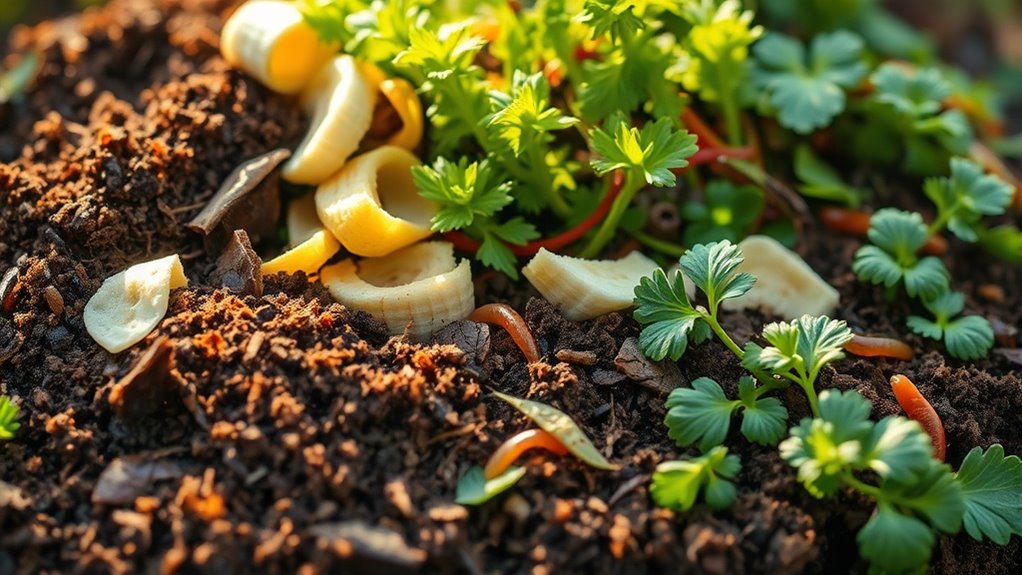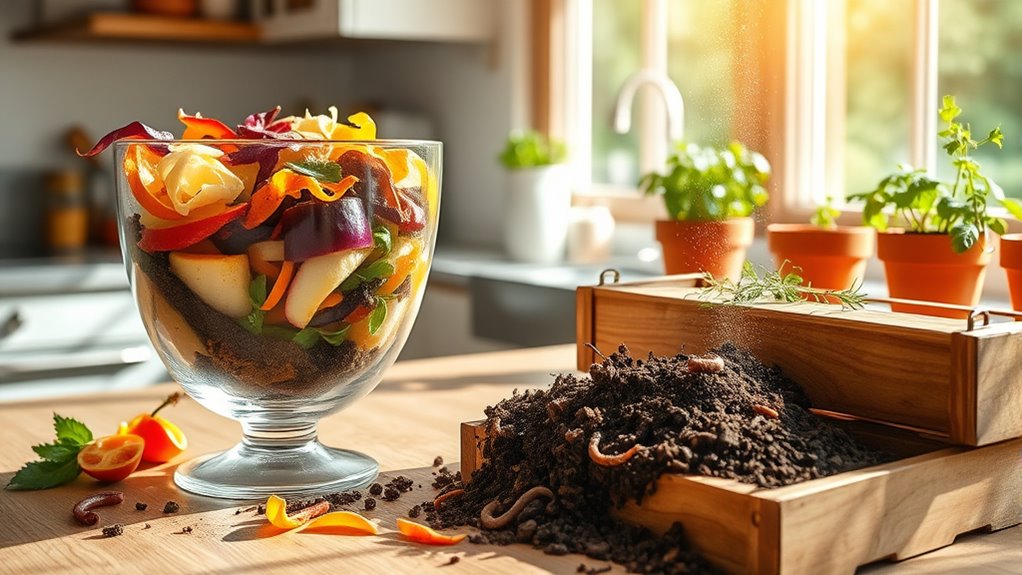Composting is an easy way to turn your kitchen scraps, like fruit peels and coffee grounds, into rich soil. Start by choosing a well-drained spot and layering brown materials, like leaves, with green scraps for a balanced mix. Maintain moisture and turn your pile every few weeks to speed up decomposition. In a few months, you’ll have dark, crumbly compost ready to boost your plants. Stick around to discover tips for optimizing your composting process!
Key Takeaways
- Collect kitchen scraps like fruit peels, vegetable trimmings, and coffee grounds while avoiding meat and dairy to prevent pests.
- Choose a well-drained, shaded area for your compost bin or pile to facilitate decomposition.
- Layer browns (like leaves and branches) with greens (like kitchen scraps) in a 2:1 ratio for optimal composting.
- Turn the compost every few weeks and maintain moisture to ensure proper aeration and decomposition.
- Harvest compost when it becomes dark and crumbly, then use it to enrich your garden or potted plants.

Have you ever wondered how to turn your kitchen scraps and yard waste into nutrient-rich soil? Composting is a fantastic way to reduce waste and create something beneficial for your garden. It’s simpler than you might think, and you’ll be amazed at the difference it can make. By following a few basic steps, you can transform your leftovers into a valuable resource.
Transform your kitchen scraps into nutrient-rich soil and reduce waste with simple composting steps for a thriving garden.
First, gather your materials. You can use fruit and vegetable peels, coffee grounds, eggshells, fallen leaves, grass clippings, and small branches. Avoid adding meat, dairy, or oily foods, as they can attract pests and create unpleasant odors. A balanced mix of “greens” (nitrogen-rich items like vegetable scraps) and “browns” (carbon-rich materials like dried leaves) will give your compost the right nutrients. Aim for a ratio of about 2:1 browns to greens for optimal results.
Next, find a suitable spot for your compost pile or bin. It should be well-drained, have good air circulation, and ideally be in a partially shaded area. If you’re using a compost bin, make sure it has ventilation holes to allow airflow. If you’re going for a pile, keep it at least three feet wide and tall. This size will help retain heat, which is essential for breaking down the materials.
As you add your scraps, remember to layer them. Start with a layer of browns, followed by greens, and repeat until you’ve used up your materials. This layering helps maintain airflow and prevents your compost from becoming too compacted. Turning your compost every few weeks is also important. This aerates the pile, speeds up decomposition, and helps distribute moisture evenly.
Moisture is key in the composting process. If your pile feels dry, add some water to it, but be careful not to soak it. A damp sponge-like consistency is ideal. You’ll know your compost is working when you see heat rising from the center and smell earthy scents instead of foul odors. Additionally, health-conscious options are gaining popularity in various sustainable practices, including composting.
After a few months, you’ll notice a dark, crumbly substance forming. This is your compost! Once it’s ready, you can use it in your garden, potted plants, or even as a top dressing for your lawn. Not only will you be reducing waste, but you’ll also be enriching your soil, promoting healthy plant growth, and making a positive impact on the environment. So, get started on composting today, and watch your kitchen scraps turn into gardening treasure!
Frequently Asked Questions
Can I Compost Meat and Dairy Products?
You shouldn’t compost meat and dairy products. They can attract pests, produce unpleasant odors, and create a risk of disease. If you want to compost effectively, focus on plant-based scraps like fruit and vegetable peels, coffee grounds, and eggshells. These materials break down easily and enrich your compost. If you’re keen on including meat and dairy, consider using a specialized composting system designed to handle those items safely.
How Long Does Composting Take to Produce Usable Soil?
Composting usually takes about three to six months to produce usable soil, depending on factors like materials and conditions. Did you know that around 30% of what we throw away could be composted? By maintaining the right balance of greens and browns, aerating your pile, and keeping it moist, you can speed up the process. So, with a little patience and care, you’ll soon have rich, dark compost ready for your garden.
What Materials Should I Avoid in Composting?
You should avoid meat, dairy, and oils in your compost. These materials can attract pests and create odors. Also, steer clear of diseased plants, weeds with seeds, and chemical-treated materials, as they can harm your compost. It’s best to skip glossy paper and non-biodegradable items, too. Stick to fruits, vegetables, and yard waste for a healthy compost that’ll break down efficiently and enrich your soil.
How Do I Maintain the Right Moisture Level in Compost?
To maintain the right moisture level in your compost, keep it damp but not dripping. You can sprinkle water on dry days or mix in wet materials like fruit scraps. If it’s too soggy, add dry ingredients like shredded paper or leaves. Check the compost regularly; it should feel like a wrung-out sponge. With a little attention, you’ll create the perfect environment for your compost to thrive!
Can I Compost if I Live in an Apartment?
Yes, you can absolutely compost in an apartment! Consider using a small compost bin or a worm bin, which are perfect for limited space. You can collect kitchen scraps like vegetable peels and coffee grounds, and add them to your bin. Just remember to balance your greens and browns for ideal decomposition. If you’re concerned about odor, guarantee proper ventilation and avoid adding meat or dairy. With a bit of effort, you’ll create nutrient-rich compost!
Conclusion
In conclusion, composting is a simple and satisfying solution for transforming your kitchen scraps into nutrient-rich soil. By diligently diving into the delightful process of decomposition, you’ll not only reduce waste but also reap the rewards of rich, rejuvenating compost. So, gather your greens and browns, mix them up, and watch nature work its wonders. With a little patience and passion, you’ll create a thriving garden that’s both eco-friendly and incredibly fulfilling!









